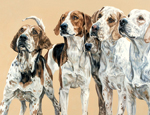Tania Still's hound paintings
Iain Gale is delighted by Tania Still's large canvases of hounds, which are currently the subject of a selling exhibition in Edinburgh


It is a much reported fact that our art schools no longer teach the practice of drawing, and concomitant with that runs the notion that painting today is generally more about expression than depiction. It is a rare treat then to find a young artist who excels at both of these neglected areas, particularly when she is also part of an underrated British tradition. Tania Still paints dogs. To be precise, she paints foxhounds, greyhounds, beagles and harriers, and she does so with such innate skill and ingenuity that I can, prob-ably without fear of contradiction, call her unique among contemporary British sporting artists. Alexander Meddowes will be exhibiting 40 of her works for sale in Edinburgh until August 17.
Tania has achieved something that has not been seen on such a scale in animal painting for more than 200 years. Taking her cue, I suspect, from George Stubbs' magisterial painting Whistlejacket, now in the National Gallery, and other similar works by that genius of British art, she often places her subjects against a neutral, dun-coloured background. Her hounds float in a void. There is simply no need for extraneous detail. The hounds are all. This is exactly as it should be, focusing our complete attention. Yet it also has another effect, perhaps unlooked for by the artist, but certainly not unwelcome. It emphasises the fact that, ultimately, these creatures are alone in a diminishing world. It is a plea for the survival of a noble species that depends for its continuing existence on the sport that sustains it. If hunting should cease to exist, then so too, inevitably, will foxhounds. Not perhaps as a breed, but most certainly as the sort of working animal that Tania depicts here so well. She is supremely sensitive to canine character, and anyone who has ever been out with hounds will recognise the reality of her sitters' expressions.
Take, for instance, her image of five hounds from the Fife hunt (above). The hound on the left guides the viewer into the picture with his extended right leg leading directly into a face frozen in anticipation. We move across to the hound to his right, following her eyes to the same point beyond the picture plane, effectively on our own side of the canvas. Three other hounds look on, pressing for attention. The point of the painting is that the focus of their gaze is a human being. Their world is encompassed by our own, whether it be food, a treat or simply the expectation of the day to come. Tania addresses her sitters with a confident vigour, applying the paint from her muted palette of whites, greys and shades of liver and brown in loose, luscious strokes. Although the overall effect is rich in texture and depth, look more closely and you will quickly see the true economy of her technique.
What also sets her apart from other young artists, however, is the sheer scale of her work. Tania's canvases can often measure as much as 6ft square, their larger-than-life size imbuing their subject matter with a real sense of the majesty normally reserved for a human sitter. That said, her works contain no hidden rhetoric suggesting that the hounds might ever supplant their master. They do, however, carry an implicit message: Tania's paintings reiterate the fact that we live in a world where, more than ever, animals are seen to exercise 'rights'. To the countryman, of course, this is no great revelation. All creatures have an innate nobility. But, by the same token, creatures also have a natural role in the shaping of the countryside a role which is sometimes necessarily brutal, the reality of which too many people fail to understand and refuse to admit. By celebrating working hounds in this way, empathising with their individuality yet containing them within their traditional role as servants of man, Tania places them in the proper context of a natural hierarchy. It is a hierarchy which is wholly dependent upon a proper understanding of the realities of countryside conservation.
These are more than mere paintings of hounds. They are as splendid an homage to a British icon as it is possible to imagine and, not least, telling metaphors for a vital truth of country life.
Tania Still's paintings are on display with Alexander Meddowes at 39, Royal Terrace, Edinburgh until August 17 (0131?558 1000; www.
alexandermeddowes.com)
Exquisite houses, the beauty of Nature, and how to get the most from your life, straight to your inbox.
Country Life is unlike any other magazine: the only glossy weekly on the newsstand and the only magazine that has been guest-edited by His Majesty The King not once, but twice. It is a celebration of modern rural life and all its diverse joys and pleasures — that was first published in Queen Victoria's Diamond Jubilee year. Our eclectic mixture of witty and informative content — from the most up-to-date property news and commentary and a coveted glimpse inside some of the UK's best houses and gardens, to gardening, the arts and interior design, written by experts in their field — still cannot be found in print or online, anywhere else.
